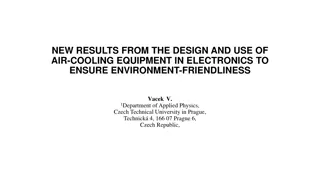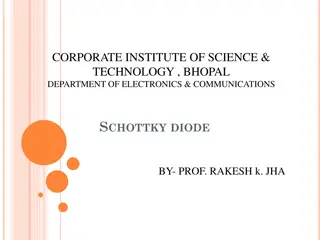Evolution of Semiconductor Devices in Modern Electronics
The lecture discusses the fundamentals of semiconductor drift and diffusion currents, diode behavior, transistor characteristics, and amplifier circuits in ECE 255. It explores the origins of modern electronics, from the invention of the bipolar transistor to the evolution of electronic devices through vacuum tubes, transistors, integrated circuits, and Moore's Law. The presentation also highlights the rapid increase in microelectronics density and the impact of feature size reductions on transistor density and device performance.
Download Presentation

Please find below an Image/Link to download the presentation.
The content on the website is provided AS IS for your information and personal use only. It may not be sold, licensed, or shared on other websites without obtaining consent from the author.If you encounter any issues during the download, it is possible that the publisher has removed the file from their server.
You are allowed to download the files provided on this website for personal or commercial use, subject to the condition that they are used lawfully. All files are the property of their respective owners.
The content on the website is provided AS IS for your information and personal use only. It may not be sold, licensed, or shared on other websites without obtaining consent from the author.
E N D
Presentation Transcript
ECE 255 Jan 9, 2018 Lecture Instructor: Weng Cho Chew
Clicker Test Question 1 Have you used clicker in class before? (A)Yes (B)No
Clicker Test Question 2 Have you registered your clicker on Black Board? (A)Yes (B)No
ECE 255 Introduction to Semiconductor Drift Currents Diffusion Currents Basic Knowledge Diode Normal Breakdown Bipolar Junction Transistor Q (Ic, VCE) Field-effect Transistor Q (IDS, VDS) DC Analysis Small Signal Model Small Signal Model Bipolar Junction Transistor Based Amplifier Voltage Gain, Av Input, Output Resistance Common-Emitter Common-Collector Common-Base Field-effect Transistor Based Amplifier Voltage Gain, Av Input, Output Resistance Common-Source Common-Drain Common-Gate AC Analysis Bipolar Junction Transistor Based Amplifier Low cutoff frequency High cutoff freqency Field-effect Transistor Based Amplifier Low cutoff frequency High cutoff freqency Frequency Analysis
The Start of the Modern Electronics Era Bardeen, Shockley, and Brattain at Bell Labs - Brattain and Bardeen invented the bipolar transistor in 1947. The first germanium bipolar transistor. Roughly 50 years later, electronics account for 10% (4 trillion dollars) of the world GDP.
Evolution of Electronic Devices Vacuum Tubes Discrete Transistors SSI and MSI Integrated Circuits VLSI Surface-Mount Circuits
Moores Law The number of transistors in a dense IC doubles approximately every two years.
Device Feature Size Feature size reductions enabled by process innovations. Smaller features lead to more transistors per unit area and therefore higher density. ISSCC--International Solid-State Circuits Conference ITRS--International Technology Roadmap for Semiconductors
Rapid Increase in Density of Microelectronics Memory chip density versus time ISSCC--International Solid-State Circuits Conference ITRS--International Technology Roadmap for Semiconductors
Figure 1.7 Analog Signal Digital Signal
The Inventors of the Integrated Circuit Andy Grove, Robert Noyce, and Gordon Moore with Intel 8080 layout. Jack Kilby
The Kilby Integrated Circuit Semiconductor die Active device Electrical contacts (wiki) As of 2016, the largest transistor count in a commercially available single-chip processor is over 7.2 billion the Intel Broadwell-EP Xeon.
Full Periodic Table (Carbon Column, Most Important)
Semiconductor Materials (cont.) Bandgap Energy EG (eV) 5.47 Semiconductor IV Carbon (diamond) IV Silicon 1.12 Germanium 0.66 IV IV Tin 0.082 Gallium arsenide 1.42 III-V Gallium nitride 3.49 III-V Indium phosphide 1.35 III-V III-V Boron nitride 7.50 Silicon carbide 3.26 IV Cadmium selenide 1.70 II-VI
Solid-State Electronic Materials Electronic materials fall into three categories: Insulators Semiconductors Conductors Elemental semiconductors are formed from a single type of atom, typically Silicon. Compound semiconductors are formed from combinations of column III and V elements or columns II and VI. Germanium was used in many early devices. Silicon quickly replaced germanium due to its higher bandgap energy, lower cost, and is easily oxidized to form silicon- dioxide insulating layers. Resistivity ( ) > 105 -cm 10-3 < < 105 -cm < 10-3 -cm
Covalent Bond Model Silicon diamond lattice unit cell. (stackable) Corner of diamond lattice showing four nearest neighbor bonding. (non-stackable) View of crystal lattice along a crystallographic axis.
Silicon Covalent Bond Model (cont.) Near absolute zero, all bonds are complete. Each Si atom contributes one electron to each of the four bond pairs. Increasing temperature adds energy to the system and breaks bonds in the lattice, generating electron-hole pairs. Holes and electrons are charge carriers.
Electron-hole Concentrations A vacancy is left when a covalent bond is broken. The vacancy is called a hole. A hole moves when the vacancy is filled by an electron from a nearby broken bond (hole current). Hole density is represented by p. For intrinsic silicon, n = ni = p. The product of electron and hole concentrations is pn = ni2. The pn product above holds when a semiconductor is in thermal equilibrium (not with an external voltage applied).
Intrinsic Carrier Concentration Recombination and thermal generation causes n and p to remain constant. The density of intrinsic carriers in a semiconductor as a function of temperature and material properties is: = = = 2 n p n np n i i E kT E kT 3/2 = = 2 i 2 3 -6 3 3/2 -3 exp cm K , G n B T exp cm K G n B T i 2 EG = semiconductor bandgap energy in eV (electron volts) k = Boltzmann s constant, 8.62 x 10-5 eV/K T = absolute temperature, K B2 = material-dependent parameter, 1.08 x 1031 K-3 cm-6 for Si B=7.3 x 1015 K-3/2 cm-3 for Si Bandgap energy is the minimum energy needed to free an electron by breaking a covalent bond in the semiconductor crystal.
Intrinsic Carrier Concentration (cont.) Electron density is n (electrons/cm3) and ni for intrinsic material n = ni. Intrinsic refers to properties of pure materials. ni 1010 cm-3 for Si Intrinsic carrier density (cm-3)
Donor Impurities in Silicon Phosphorous (or other column V element) atom replaces silicon atom in crystal lattice. Since phosphorous has five outer shell electrons, there is now an extra electron in the structure. Material is still charge neutral, but very little energy is required to free the electron for conduction since it is not participating in a bond. n type doped silicon with phosphorous. Electron carrier density (concentration) n is increased. (electron concentration n D n N donor concentration)
Doping to Change Carrier Density = n N 2 i p n n 2 i n n p n D N n p n D i n n Minority carrier Majority carrier
Acceptor Impurities in Silicon Boron (column III element) has been added to silicon. There is now an incomplete bond pair, creating a vacancy for an electron. Little energy is required to move a nearby electron into the vacancy. As the hole propagates, charge is moved across the silicon.
Acceptor Impurities in Silicon (cont.) Hole is propagating through the silicon. p type doped silicon with phosphorous. Hole carrier density or concentration p is increased. (hole concentration p A p N acceptor concentration)
Prior Concepts You Need to Know Kirchhoff s Voltage and Current Laws Thevenin & Norton Theorem: Any linear electrical network with voltage and current sources and only resistors can be replaced at terminals by an equivalent voltage source, Vth, and an equivalent resistance, Rth.
Clicker Question 1 (0 Point) What is the intrinsic carrier density (ni) of Si at room temperature: (A)1010 cm-3 (B)1022 cm-3 (C)104 cm-3
Clicker Question 2 (0 Point) How many Si bonds are broken by thermal energy at room temperature? (A)10% (B)100% (C) ~1 per 1013 bonds (D)50%
Clicker Question 3 (0 Point) Si: T=300K, ND=1017/cm3, is it n type or p type? (A)n type (B)p type (C) intrinsic
Clicker Question 4 (0 Point) Si: T=300K, ND=1017/cm3, hole concentration p=? (A)1017/cm3 (B)0/cm3 (C)1010/cm3 (D)103/cm3













